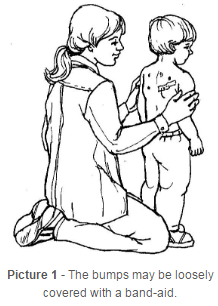Molluscum
![]()
Molluscum (muh LUSS kuhm) are smooth, pearly, skin-colored, benign bumps on the skin. They are very common in children. They begin as small bumps and they may grow as large as a pencil eraser. Molluscum are caused by a virus. It is difficult to know the source of the virus, but children often spread them on themselves and to each other.
The bumps usually appear on the face, neck, armpit, arms and behind the knees. They can be anywhere on the body except the palms of the hands and soles of the feet. Usually they are found in lines or groups where the child has scratched.
Care at Home
Dermatology
Looking for services or physicians who can help treat this condition?
The bumps can last from a few months to a few years. They usually go away by themselves. They can be itchy. These tips will help keep your child more comfortable and prevent spreading the virus to other areas:
- Be sure to keep the affected areas clean and dry.
- Teach your child to carefully wash his hands, paying special attention to the fingernails. (Refer to the Helping Hand: Hand Hygiene, HH-IV-80.)
- All children should avoid sharing towels, bed linens and clothing.
Child Care or School

- Children, who have molluscum, are not a health risk to others and they do not need to be kept away from child care or school.
- Molluscum may be loosely covered with a Band-Aid® to reduce scratching and further irritation and infection.
- Remind your child about careful hand washing while at school or child care.
When to Call the Doctor
Call your child’s doctor if:
- You think an infection has formed (redness, oozing or drainage with odor; your child’s skin feels hot to the touch).
- The infection seems to be spreading over a large part of the body.
- The molluscum are present for longer than a year.
Treatment
In healthy children, the virus usually goes away on its own within a few months to a few years. Molluscum often appear red and irritated before they go away. Sometimes they can leave behind very small depressed scars. Often, no treatment is needed.
However, in more severe cases, a doctor may treat the bumps to keep the virus from spreading on the child. Types of treatment include medicine that is put on the bumps, liquid nitrogen treatment, and curettage (removing the growths).
-
Topical medication – Different medicines may be prescribed to put on the molluscum once a day. This can be irritating to the skin and cause some redness, so it should not be put on healthy skin.
-
Liquid nitrogen – Freezing with liquid nitrogen is another form of treatment. Liquid nitrogen is put on with a cotton applicator. It feels hot for a moment, and then may form a blister at the site. See the Helping Hand: Warts: Liquid Nitrogen Treatment, HH-I-156.
- Curettage – Your child’s doctor may decide to remove molluscum by scraping the bump or removing the center. This is done only after numbing the area with a special cream.
All of these treatments cause some discomfort. Sometimes more than one treatment is needed.
Follow Up Appointment
If a treatment has been used, the doctor will probably want to see your child again in a few weeks. More than one treatment may be needed. If you have any questions, be sure to ask your child’s doctor or nurse.
HH-I-198 4/99 Revised 1/16 Copyright 1999-2010, Nationwide Children’s Hospital

